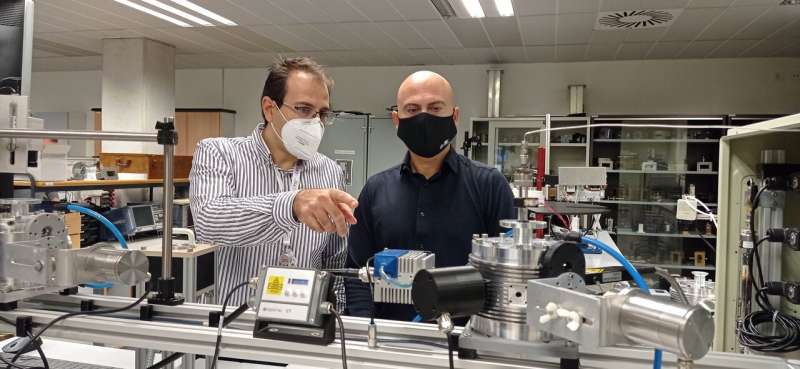Researchers discover a new way to produce hydrogen using microwaves

A team of researchers from the Polytechnic University of Valencia and the Spanish National Research Council (CSIC) has discovered a new method that makes it possible to transform electricity into hydrogen or chemical products solely using microwaves—without cables and without any type of contact with electrodes. This represents a revolution in the field of energy research and a key development for the process of industrial decarbonisation, as well as for the future of the automotive sector and the chemical industry, among many others. The study has been published in the latest edition of Nature Energy, where the discovery is explained.
The technology developed and patented by the UPV and CSIC is based on the phenomenon of the microwave reduction of solid materials. This method makes it possible to carry out electrochemical processes directly without requiring electrodes, which simplifies and significantly cheapens its practical use, as it provides more freedom in the design of the structure of the device and choosing the operation conditions, mainly the temperature."It is a technology with great practical potential, especially for its use in storing energy and producing synthetic fuels and green chemical products. This aspect has significant importance today, as both transportation and industry are immersed in a transition to decarbonise, meaning they have to meet very demanding goals between 2030 and 2040 to decrease the consumption of energy and substances from fossil sources, mainly natural gas and oil," highlights José Manuel Serra, research lecturer of the CSIC at the Chemical Technology Institute.
Green hydrogen for industrial and transportation uses
The main use of this revolutionary technology is the production of green hydrogen (produced without emitting greenhouse gasses) from water for industrial and transportation uses. As noted by the ITQ and ITACA team, it is a technology with great potential for the automotive sector, specifically for cars fuelled by fuel cells and hybrids or large vehicles such as trains or ships. But also for the chemical industry, metallurgy, the ceramic sector or the production of fertilizers, among many other sectors.
"This method will make it possible to transform renewable electricity, typically of solar or wind origin, into added value products and green fuels. It has countless uses and we hope that new uses emerge for the storing of energy, developing new materials and chemical production," highlights José Manuel Catalá, researcher at the ITACA institute of the UPV.In the article published in Nature Energy, the researchers also provide a technical and economic study that shows that this technology would make it possible to obtain high energetic efficiency, and that the cost of the facilities to carry out the hydrogen production process are very competitive compared to conventional technologies.
Ultra-fast charging of batteries… and space exploration
The UPV and CSIC team is studying other future uses for this technology, and is currently focusing its efforts on its use for the ultra-fast charging of batteries "Our technology could enable a practically instantaneous decrease in the size of the electrode (metallic anode) that stores energy. In other words, we would go from a layer-based progressive charging process, which can take hours, to a simultaneous process in the entire electrolyte, which would make it possible to charge a battery in a few seconds," says José Manuel Catalá.
Another use would be the direct generation of oxygen with microwaves, which opens a broad spectrum of new uses. "One specific use would be the direct production of oxygen with extra-terrestrial rocks, which could have a key role in the future exploration and colonization of the moon, Mars or other rock bodies of the solar system," concludes José Manuel Serra.
A short history of the discovery
The team of researchers observed that when ionic materials were being treated with microwaves, the materials displayed unusual changes in their properties, especially their electronic conductivity, changes that did not happen when they were heated conventionally. "Our curiosity to understand these sudden changes in their electrical properties made us dig deeper, designing new experiments, new microwave reactors and to apply other analytical techniques," explains José Manuel Catalá.
The team from the ITACA and ITQ institutes verified that microwaves interact with these materials by accelerating the electrons and giving way to the release of molecules of oxygen from their structure (which is also called reduction). This change manifested itself specifically with sudden alterations to the conductivity at relatively low temperatures (approximately 300ºC). "This semi-balanced state is maintained while microwaves are applied, but tends to revert back by way of reoxygenation (reoxidation) when microwaves cease being applied. We soon realized the great practical potential of this discovery, especially at a juncture such as the one we are in today, of progressive decarbonisation, which is required to reach the goal of the European Union being climactically neutral in 2050, an economy with zero net greenhouse gas emissions," concludes José Manuel Serra.
More information: J. M. Serra et al. Hydrogen production via microwave-induced water splitting at low temperature, Nature Energy (2020). DOI: 10.1038/s41560-020-00720-6


















